This little Salvia greggii pushing out a few blooms this week is emblematic of how small, well-timed interventions can mean a lot, especially in small gardens. The salvia was getting swamped in a stock tank and it became a case of move it or lose it. So it was transplanted into the gravel in front of the tank maybe a month ago and trimmed back a bit. And that’s how I was gifted with this translucent performance this morning. I’m very curious how salvias like these greggii/microphylla will perform here. I’m hoping til frost, of course. Just a few can make such a difference in late summer. Also growing ‘Nachtvlinder,’ ‘Mesa Azure,’ which wintered over, and ‘Amethyst Lips‘ — ‘Oriental Dove.’
The annual Madia elegans is sprawling its 5-foot stems in all directions, over the melianthus and aralia. I say sprawl away, because every day there’s a new association to appreciate by virtue of its clever insinuations into surrounding plants.
Crocosmia grows like mad in coastal Oregon. For the most part, they appear to be the dark red ‘Lucifer.’ I skip a lot of easy-going plants I’m seeing locally but made an exception for crocosmia. Nice leaves, nice timing of bloom in mid to late summer. For a homework assignment, I dare you, go ahead and choose a crocosmia. It’ll make you crazy, there are so many cultivars, and to the uninitiated (me) the differences seem slight. I defaulted back to an old cultivar ‘Solfatarre’ I have grown in zone 10. Surprised me by blooming after an early summer planting.
Second summer for Heliopsis ‘Bleeding Hearts.’ Kind of a thin performance? I like it fine. Sure, helenium has masses more flowers, but that comes with masses of leaves. Heliopsis serenely floats over its neighbors, slim footprint, good manners, not too pushy.
The next photos are from the southeast corner of the garden, that has to contend with the neighboring tree roots just over the fence. Here all the fizzy, floating things congregate, coming into full bloom in August. In addition to the heliopsis, there’s gaura, Scabiosa ochraleuca, Succisella inflexa, Rudbeckia triloba, agastache.
A pale mass of froth and foam, static in photo, but a dynamic little corner that draws me in every morning. Dechampsia ‘Goldtau’ has been good here since spring, now casting a gold net through the planting.
A lackluster photo of some plants that deserve better. The grey leaves belong to mountain mint, Pycnanthemum muticum, backed by Joe-Pye weed. Apparently I have the same taste in plants as insects do. I love the buxomy, plush grey mounds of mountain mint and planted it for these attributes, not knowing of its renown for attracting pollinators. Now I know!
Apart from red clover, I’ve never seen another plant bristling with so much buzzy activity.
Since I arrived in coastal Oregon, I’ve been determined to find a use for the easily obtained oyster shells that form large mounds/middens along the coast. Huge amounts are consumed from the local bays. Without equipment to crush the shells for pathways, my bags of oyster shells lay idle over winter in the vegetable garden. A mail-order gabion was the answer, topped with a former bridge light shade gifted from a blogger meet-up last fall. I’m beginning to feel like a local now! More August Bloom Day stories at May Dreams Gardens.



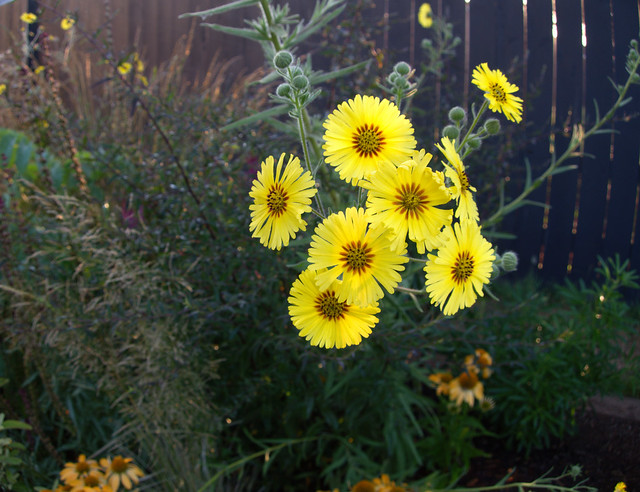
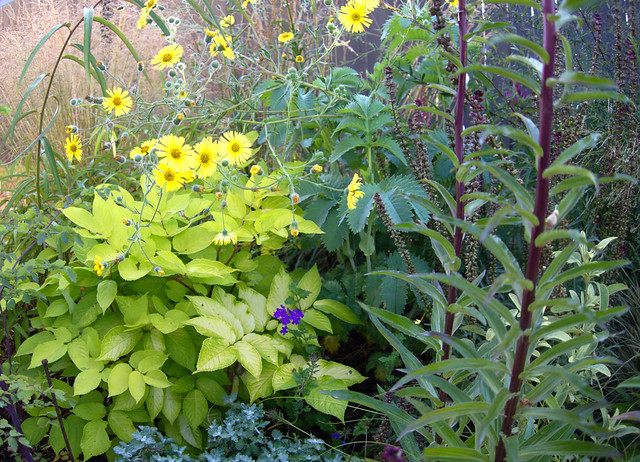
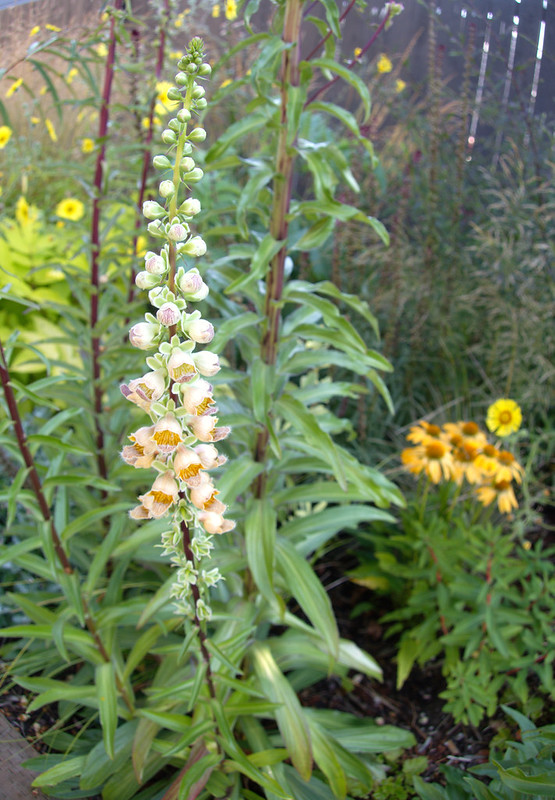
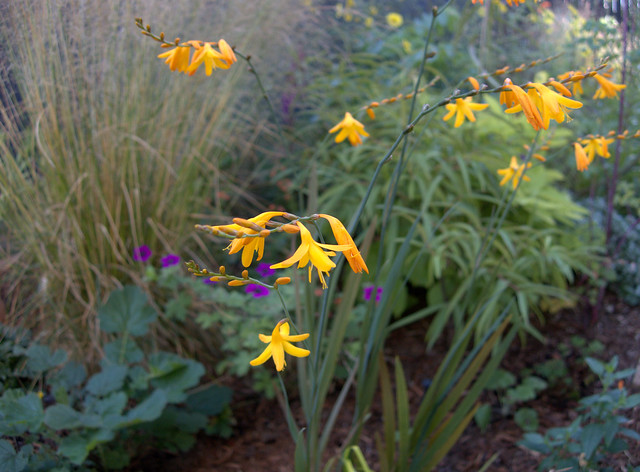




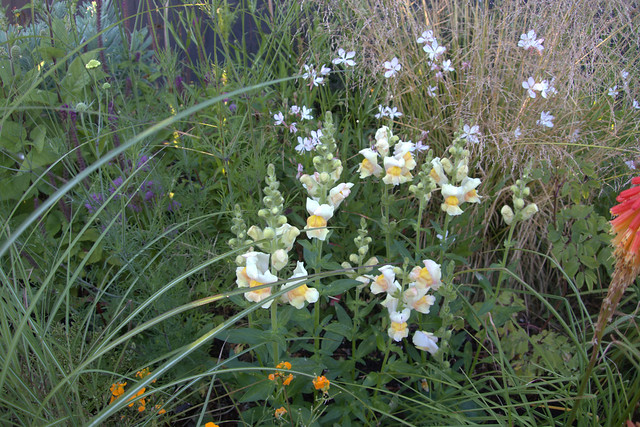






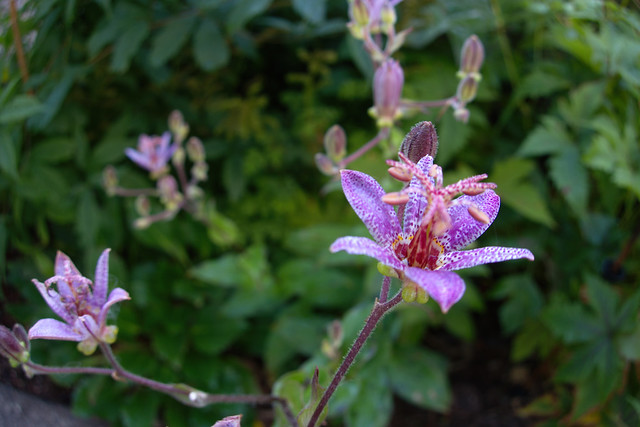



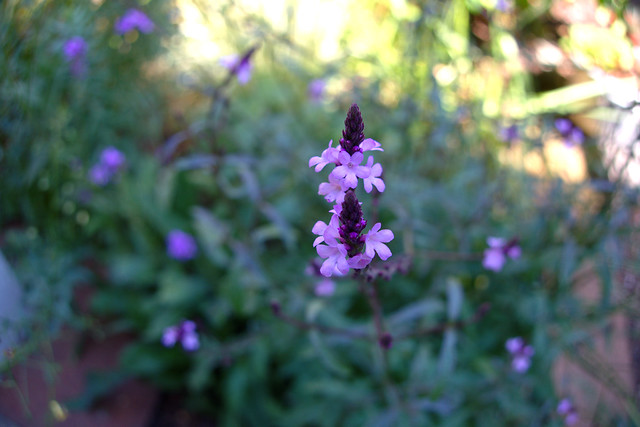

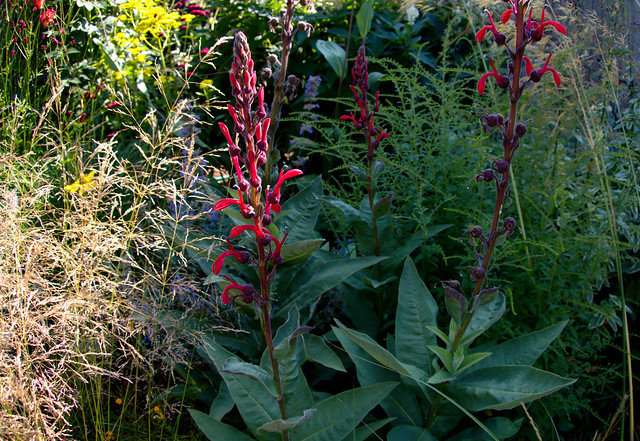

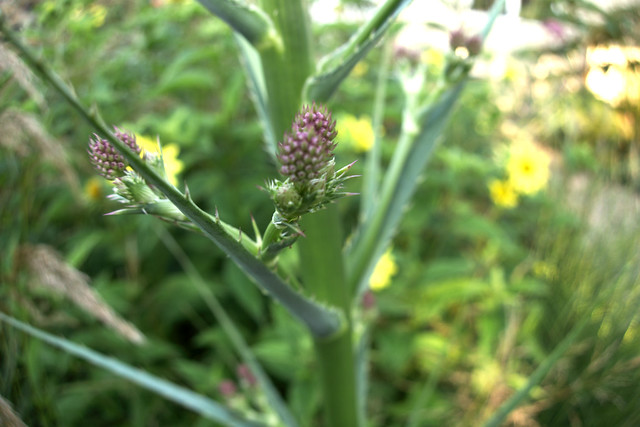

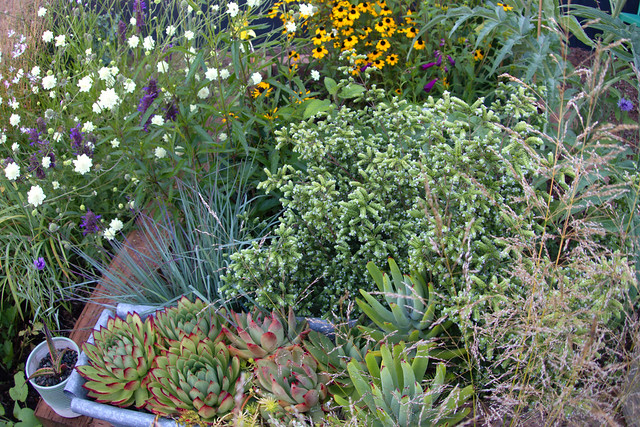


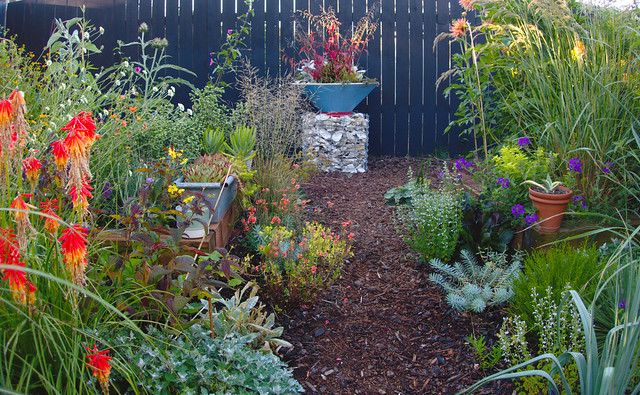
So many beautiful plants I can’t even imagine growing in my SoCal garden – toad lilies, Heliopsis, summer snapdragons! But my brain ceased functioning when you described your 8-foot tall dahlia with 30 blooms…My own Bloom Day post will be a day late and very light on dahlias.
The garden is at it’s peak and looking beautiful and blousy. Love those Salvia microphylla’s. I have a cerise pink one and ‘Hot Lips’. The hummingbirds fight over them. Can’t imagine a 8’tall dahlia with 30 blooms. Amazing! You definitely are becoming a PNW native.
@Kris, it’s probably closer to 50 blooms! And tbh, it’s a little too much for the garden. I’ll probably move it to the veg garden and try something else — checked Rosebud’s listing and it’s described as a 4 or 5-footer. So two out of the original four dahlias are fence-toppers, two are about 3 feet in height.
@Elaine, I’ve got two hummingbird visitors, a far cry from all the hummers in zone 10 — need to plant more salvias!
I love the oyster shell filled gabion, the perfect plinth for that planter! As for my favorite crocosmia, it has to be ‘Star of the East’. I was given a few corms a friend dug from her garden and it is the perfect orange for me.
@Loree, I was surprised at how the scale of the light shade worked out with the gabion — even Marty likes it, and he was dubious about the plan. And thanks for the crocosmia tip. I have grown that one in zone 10, but as we know it will be a different plant up here!
So many plants I could never hope to grow. Love the height of your Eryngium pandanifolium!
As for Madia elegans, did you start it from seed? I want to try it.
Snapdragons in August, what a hoot to hot-summer eyes, wood aster dainty, frothy, no lie. And sawdust restaurants with oyster-shells? Better in a gabion.
@Gerhard, I did try it from seed sown in situ, no luck, so brought in a couple plants. If I tried seed again, I’d sow it in spring in trays or pots. I know it does self-sow, so maybe this year I’ll get some more plants.
@Hoov, crushing oyster shells for paths, bocce courts, etc. takes serious equipment! Me and a hammer? No way!
I love crocosmia but on the whole I find them too prolific. Such is C. lucifer where now I only keep a few corms for the hummers. A small variety (noID) more than doubled in size in one season so it too had to go.
The nameless variety that got to stay has medium hight, blooms soft orange now, in part sun/semi shade and lights up the back terraced garden.
I’d be happy to send you corms.
Chavli, thanks for the info and that generous offer! I’m remembering that ‘Solfatarre’ is a fairly weak grower as far as crocosmias go, not as hardy as some, so I’ll stick with it for now.
So much color and still lush despite being in the middle of August. Quite a contrast from all the tans and browns we have over here. I have a feeling you won’t need to buy plants or sow seed from Madia again. I think they will prolifically reward you as long as you aren’t deadheading them. I find the herby, bitter scent that wafts off the leaves in the heat rather pleasant. The ones with the red are my favorites.